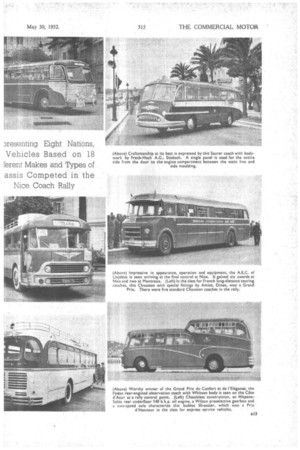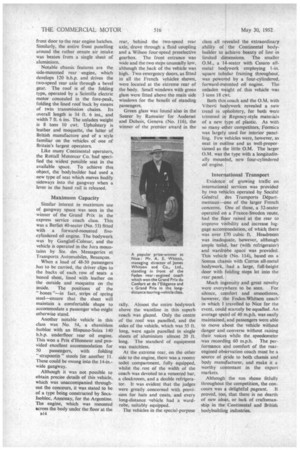Continent's Best in International Rally
Page 46

Page 47

Page 48

If you've noticed an error in this article please click here to report it so we can fix it.
By Alfred Woolf, B.A. Dresenting Eight Nations, Vehicles Based on 18 ferent Makes and Types of assis Competed in the
Nice Coach Rally
IGHT nations—Britain, France, Belgium, Holland, Sweden, 'Germany, Switzerland and Italy—were represented in the 2nd Rallye Touristique Europe-Cate d'Azur and the 5th Concours International d'Autocars which took place at Nice from May 19-23. For the final judging, 39 coaches, based on 1g different makes of chassis and with bodywork by 31 coachbuilders, lined up on the Promenade des Anglais. Against severe competition, Britain succeeded in carrying off four Crands Prix, two in the rally and two in the coneours, apart from smaller awards.
The two sections of the event are complementary, hut are organized independently. No particular starting date is laid down for the rally, which comprises a normal Continental tour undertaken with passengers and crew. Each vehicle must, however, arrive at Nice at a given time, and must produce evidence of having passed through a number of control points en route.
Passengers' Opinions
Based on reports given by passengers and received from the control points, and on the opinion of the judges, prizes are awarded for such matters as time-keeping, the organization of the tour, the facilities provided for the passengers, and for the manner in which the tourists have been looked after and shown round places of historic or Scenic interest.
There are eight awards in the rally. The principal award, presented by the President of the French Republic, was gained by an operator from Caen, with a Somua coach (No. 114) carrying a party organized by Cie des Wagons-Lits Cook.
A magnificent Saurer rear-engined coach with bodywork by Rarnseier and Jantzen, Geneva, reputed to have cost iI 7,000, was awarded the Grand Prix de Toutes Categories, whilst the Grand Prix du Confort et de l'Eldgance once again was gained by James Whitson and Co., Ltd., West Drayton, Middx., with a Foden rearengintx1 observation coach operated by Salopia Saloon Coaches, Ltd., Whitchurch, Salop. This was the fifth occasion on which James Whitson had gained a premier award.
The only other British vehicle in the competition was an A.E.C. Regal Mk. HI with bodywork by Park Royal Vehicles, Ltd., Park Royal, London, N.W.10, one of 50 of this type operated by A/B Linjehus, Stockholm. This was awarded the Grand Prix des Services Routiers Tnternationaux, and was a worthy winner, for the vehicle had left Kirinu, in Lapland, 11 days before arriving at Nice, with a party of Swedish tourists. The tour eventually will have covered over 5,000 miles, mainly over routes operated rcluIarly by Linjebus from Helsingborg.
The Concours d'Elegance starts two days after the arrival of the vehicles at Nice. This year, although 55 entrants had been received, not all were present for judging. Some vehicles had not been completed in time, and in other cases operators had been unable to acquire sufficient bookings for the coaches to compete in the event.
At least three vehicles—a Saurer rear-engined 32-seater with fine coachwork by Frech-Hoch A.G., Sissbach, Switzerland, an O.M. Leoncini 14-seater by Autocostruzione Casaro, Turin, and an O.M. Super-Taurus of S.A.T.I., Genoa, with Viberti bodywork—arrived at Nice only a few hours before judging began.
There are three principal categories in this section of the competition. The largest class is normally that for long-distance touring coaches, which, this year, attracted 10competitors, compared with 17 in the class for special-purpose vehicles (such as 12-14-seaters) and four in , the category for express-service vehicles.
British Successes
When the results were announced late on May 22, both the British vehicles had gained Grands Prix in the first category. Similar awards were won by two German vehicles, . both based on Bussing underfloorengined chassis with bodywork by Emrnelmann A.G., Frankfurt, the finish of which, both in exterior paintwork and interior trim, was highly commended.
Not even the German-built coaches could be compared with the two Swiss vehicles in respect of finish. The smaller vehicle, with 'Freeh-Hoch bodywork (No. 163), was built for Rottal Motorcar Co.. Ltd., Lucerne. All-steerframing was employed in this design, which was notable for the use of exterior panelling which extended continuously for he full length of the body from the
front door to the rear engine hatches. Similarly, the entire front panelling around the rather ornate air intake was beaten from a single sheet of aluminium.
Notable chassis features are the side-mounted rear engine, which develops 120 b.h.p. and drives the two-speed rear axle through a bevel gear. The roof is of the folding type, operated by a Scintilla electric motor concealed in the fore-peak, folding the lined roof back by means of twin transmission chains. Its overall length is 34 ft. 6 ins., and width 7 ft. 6 ins. The unladen weight is 8 tons 10 cwt. Upholstery is leather and moquette, the latter of British manufacture and of a style familiar on the vehicles of one of Britain's largest operators.
Like many Continental operators, the Rottall Motorcar Co. had specified the widest possible seat in the available space. To achieve this object, the bodybuilder had used a new type of seat which moves bodily sideways into the gangway when a lever in the hand rail is released.
Maximum Capacity Similar interest in maximum use of gangway space was seen in the winner of the Grand Prix in the express service coach class. This was a Berliet 40-seater (No. 53) fitted with a forward-mounted fivecylindered oil engine. The bodywork was by Gangloff-Colmar, and the vehicle is operated in the Jura mountains by Ste. des Messageries et Transports Automobiles, Besancon.
When a load of 48-50 passengers has to be carried, the driver clips to the backs a each, row of seats a boned sheet, lined with leather on the outside and moquette on the inside. The positions of the "bones "—in fact, strips of spring steel—ensure that the sheet will maintain a comfortable shape to accommodate a passenger who might otherwise stand.
Another notable vehicle in this class was No. 54, a chassisless Isobloc with an Hispano-Suiza 140 b.h.p. underfloor rear oil engine. This won a Prix d'Honneur and provided excellent accommodation for 50 passengers, with folding " strapontin " stools for another 11. These could be swung into the 14-in.wide gangway.
Although it was not possible to obtain precise details of this vehicle, which was unaccompanied throughout the concours, it was stated to be of a type being constructed by SocaIsobloc, Annonay, for the Argentine. The engine, which was mounted across the body under the floor at the rear, behind the two-speed rear axle, drove through a fluid coupling and a Wilson four-speed preselective gearbox. The front entrance was wide and the two steps unusually low, although the back of the vehicle was high. Two emergency doors, as fitted in all the French vehicles shown, were located at the extreme rear of the body. Small windows with green glass were fitted above the main side windows for the benefit of standing passengers.
Green glass was found also in the Saurer by Ramseier for Auderset and Dubois, Geneva (No. 116), the winner of the premier award in the rally. Almost the entire bodywork above the waistline in this superb coach was glazed. Only the centre of the roof was panelled, and the sides of the vehicle, which was 35 ft. long, were again panelled in single sheets of aluminium almost 20 ft. long. The standard of equipment was matchless.
At the extreme rear, on the other side to the engine, there was a roomy toilet compartment, fully equipped, whilst the rest of the width of the coach was devoted to a veneered bar, a cloakroom, and a double refrigerator. It was evident that the judges were greatly concerned with provision for hats and coats, and every long-distance •vehicle had a wardrobe, suitably equipped.
The vehicles in the special-purpose class all revealed the extraordinary ability of the continental bodybuilder to achieve beauty of line in limited dimensions. The smaller 0.M., a 14-seater with Casaro allmetal bodywork employing 1-in. square tubular framing throughout, was powered by a four-cylindered, forward-mounted oil engine. The unladen weight of this vehicle was 3 tons 18 cwt.
Both this coach and the O.M. with Viberti bodywork revealed a new trend in upholstery, for both were trimmed in Regency-style matetials of a new type of plastic. As with so many other competitors, Formica was largely used for interior panelling. Few vehicles were, however, as neat in outline and as well-proportioned as the little O.M. The larger O.M. was the type with a longitudinally mounted, new four-cylindered oil engine.
International Transport
• Evidence of growing traffic on international services was provided by two vehicles operated by Socidte Gen&al des Transports D6partmentaux—one of the larger French concerns. One of these, a 32-seater operated on a France-Sweden route, had the floor raised at the rear to improve visibility and increase luggage accommodation, of which there was over 170 cubic ft. Headroom was inadequate, however, although ample toilet, bar (with refrigerator) and wardrobe space was provided. This vehicle (No. 114), based on a Somua chassis with Currus all-metal bodywork, had a large, full-height door with folding steps let into the rear panel Much ingenuity and great novelty were everywhere to be seen. For silence, comfort and smoothness, however, the Foden-Whitson coach' in which I travelled to Nice for the event, could scarcely be equalled. An average speed of 40 m.p.h. was easily maintained, and passengers were able to move about the vehicle without danger and converse without raising their voices while the speedometer was recording 60 m.p.h. The performance and comfort of the rearengined observation coach must be a source of pride to both chassis and body manufacturer, and make it a worthy contestant in the export markets.
Although the sun shone fitfully throughout the competition, the concours was a delightful pageant. It proved, too, that there is no dearth of new ideas, or lack of craftsmanship in the Continental and British bodybuilding industries.




























































































